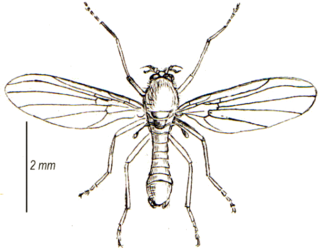
The family Sciomyzidae belongs to the typical flies (Brachycera) of the order Diptera. They are commonly called marsh flies, and in some cases snail-killing flies due to the food of their larvae.

Psychodidae, also called drain flies, sink flies, filter flies, sewer flies, or sewer gnats, is a family of true flies. Some genera have short, hairy bodies and wings, giving them a "furry" moth-like appearance, hence one of their common names, moth flies. Members of the sub-family Phlebotominae, which are hematophagous, may be called sand flies in some countries, although this term is also used for other unrelated flies.

Thaumaleidae, the solitary midges or trickle midges, are a group of nematoceran flies related to the Ceratopogonidae, Chironomidae, and the Simuliidae. They are small, stocky, yellow to brown flies (3–4 mm). Very few species are known for this family. Larvae are found in films on rocks and the nonfeeding adults are usually found on foliage along the same streams in which the larvae are found. A few solitary midges are found in the Southern Hemisphere, but Thaumaleidae are generally an Holarctic family.

The Blephariceridae, commonly known as net-winged midges, are a nematoceran family in the order Diptera. The adults resemble crane flies except with a projecting anal angle in the wings, and different head shape, absence of the V on the mesonotum, and more laterally outstretched, forward-facing legs. They are uncommon, but dozens of genera occur worldwide, and over 200 species.

The Psychodinae are the nominate subfamily of moth flies (Psychodidae), also known as drain flies. Like most of their relatives, they are usually found in damp habitats; some occur in caves. The small larvae are aquatic or semi-terrestrial; the adults are winged and capable of flight. Psychodinae are found worldwide, including some subantarctic islands.

The Helosciomyzidae are a small family of flies found exclusively in the Southern Hemisphere. With the exception of the South American genus Sciogriphoneura, helosciomyzids occur only in Australia and New Zealand.

Clogmia is a genus of drain flies in the subfamily Psychodinae.
Sycorax is a genus of moth flies and sand flies in the family Psychodidae. There are at least 40 described species in Sycorax.

Sciomyzinae is a subfamily of flies in the family Sciomyzidae.
Feuerborniella is a genus of flies belonging to the family Psychodidae.
Peripsychoda is a genus of flies belonging to the family Psychodidae.
Panimerus is a genus of flies belonging to the family Psychodidae.
Ulomyia is a genus of flies belonging to the family Psychodidae.
Boreofairchildia is a genus of moth flies in the subfamily Bruchomyiinae. Species have been recorded from the Americas, principally Central and South America, with many, including the type, transferred from the genus Nemopalpus.

The subfamily Bruchomyiinae contains genera of moth flies in the order Diptera, was originally described by the American entomologist Charles Paul Alexander.

Notofairchildia is a genus of moth flies in the subfamily Bruchomyiinae. Species have been recorded principally from South America, with many, including the type, transferred from the genus Nemopalpus.
Laurenceomyia is a genus of moth flies in the subfamily Bruchomyiinae. Species have been recorded principally from south America, with many, including the type, transferred from the genus Nemopalpus.
Bruchomyia is a genus of moth flies in the subfamily Bruchomyiinae. Species have been recorded principally from South America.
The Horaiellinae is subfamily of moth flies in the order Diptera.
Didicrum is a genus of the family Psychodidae and has a handful of species studied so far. The discovery of this genus in Colombia represents a significant range extension for Didicrum as all previously described species of this genus are distributed in the Australasian region and the southernmost portion of South America.










